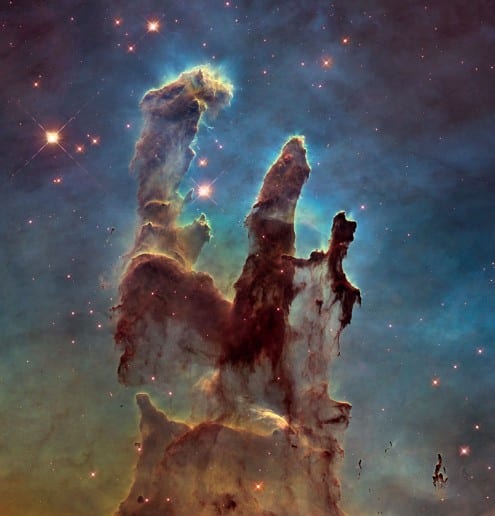Happy birthday Hubble
By Oli Usher, on 20 April 2015
This week marks the NASA/ESA Hubble Space Telescope’s 25th birthday. Since its launch on 24 April 1990, it has revolutionised astronomy, playing a role in huge scientific events including the first images of exoplanets and the measurement of the rate of expansion of the universe.
Along the way, it has taken stunning, sharp images of space that are now icons of popular culture.

One of Hubble’s famous images, the ‘Pillars of Creation’ in the Eagle Nebula. Credit: NASA, ESA and the Hubble Heritage Team
At 25, the telescope has lasted far longer than was ever planned. But thanks to regular servicing over the years, most recently in 2009, NASA’s engineers calculate the telescope still has a few years of operation left before its hardware begins to wear out. It should even last long enough to see the first few years of operations of its successor, the James Webb Space Telescope, which launches in 2018.
Hubble had a long and difficult gestation – the idea dates back to the 1940s, with design work beginning in the ‘70s. By the early 1980s, amid rising costs and political controversy, it was clear that the US couldn’t deliver Hubble alone, so the European Space Agency was brought in as a partner.
Since then, Hubble has been an international project, with staff from around the world working on the telescope, and observing time awarded to astronomers from around the world in annual competitions. Among them have been a fair few from UCL.
Hubble science comes in different flavours.
Most of the telescope’s time is devoted to observations carried out on behalf of small teams of astronomers. If their proposal is considered to be scientifically interesting, they will get to observe their chosen targets and use the data for their research. After a year, the data is uploaded to an online archive for anyone – other scientists, or even members of the public – to view. Surprisingly, perhaps, these archival observations are still incredibly useful, and they end up being used in huge numbers of studies, often making important discoveries that are totally unrelated to the original plan.
As well as these small projects, a proportion of Hubble’s time is set aside for bigger projects. These might be a systematic survey of dozens of galaxy clusters, or a highly detailed map of a large, nearby galaxy. These surveys are carried out in order to create large, comprehensive archives that can be used for a wide range of different scientific goals.
UCL astronomers have been involved with the full range of Hubble science over the years.
On Wednesday, the UCL Science blog will cover a few of the research highlights from UCL’s work with Hubble over the years.
One Response to “Happy birthday Hubble”
- 1
 Close
Close




happy birthday Hubble